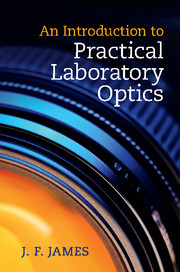Description
An Introduction to Practical Laboratory Optics
Author: James J. F.
This book is aimed at students taking practical laboratory courses in experimental optics to help them understand the components within optical instruments.
Language: English
Subject for An Introduction to Practical Laboratory Optics:
Approximative price 80.98 €
In Print (Delivery period: 14 days).
Add to cart
An Introduction to Practical Laboratory Optics
Publication date: 09-2014
196 p. · 15.6x23.5 cm · Hardback
Publication date: 09-2014
196 p. · 15.6x23.5 cm · Hardback
Approximative price 31.44 €
In Print (Delivery period: 14 days).
Add to cart
An Introduction to Practical Laboratory Optics
Publication date: 09-2014
196 p. · 15.1x22.7 cm · Paperback
Publication date: 09-2014
196 p. · 15.1x22.7 cm · Paperback
Description
/li>Contents
/li>Biography
/li>
Aimed at students taking laboratory courses in experimental optics, this book introduces readers to optical instruments and their uses. The book explains the basic operation of lenses, mirrors, telescopes in the laboratory and under field conditions, how to use optical instruments to their maximum potential and how to keep them in working order. It gives an account of the laws of geometrical optics which govern the design, layout and working of optical instruments. The book describes the interactions of polarised light with matter and the instruments and devices derived from this, and discusses the choice of spectrometers and detectors for various spectral regions, with particular attention to CCD cameras. The emphasis throughout is on description, with mathematical precision confined to the appendices, which explain the ray transfer matrix and outline the Seidel theory of optical aberrations. The appendices also introduce Fourier methods in optics and Fourier transform infra-red spectrometry.
1. Introduction: centred optical systems; 2. Telescopes and binoculars; 3. Eyepieces, eyes and colour; 4. Cameras and camera lenses; 5. The scientific CCD camera; 6. Spectrometry; 7. Interferometers and their uses; 8. Electro-optical effects and their uses; 9. Microscopes and projectors; 10. Siderostats and coelostats; 11. The detection and measurement of radiation; 12. Practicalities; Further reading; Appendices; Index.
J. F. James has held teaching positions at The Queen's University, Belfast, and the University of Manchester, and is one of the pioneers of Fourier spectroscopy. He is the author of A Student's Guide to Fourier Transforms, now in its third edition, and Spectrograph Design Fundamentals (Cambridge University Press, 2011 and 2007 respectively).
© 2024 LAVOISIER S.A.S.

